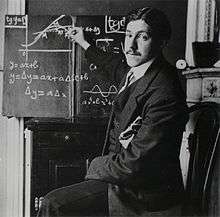Marcel Dassault
| Marcel Dassault | |
|---|---|
 Marcel Bloch in 1914 | |
| Born |
Marcel Bloch 22 January 1892 Paris, France |
| Died |
17 April 1986 (aged 94) Neuilly-sur-Seine, France |
| Resting place | Passy Cemetery |
| Nationality | French |
| Alma mater |
Breguet School Supaéro |
| Occupation | aircraft industrialist |
| Known for | founding Dassault Aviation |
| Religion | Roman Catholicism |
| Spouse(s) | Madeleine Minckes |
| Children |
Serge Dassault Claude Dassault |
| Awards | Daniel Guggenheim Medal (1976) |
Marcel Dassault born Marcel Bloch, 22 January 1892 – 17 April 1986, was a French aircraft industrialist.
Early life
Bloch was born on 22 January 1892 in Paris. Both of his parents were Jewish.
He was educated at the Lycée Condorcet in Paris. He graduated from the Breguet School and Supaéro.
Career
Bloch invented a type of aircraft propeller used by the French army during World War I and in 1928 founded the Société des Avions Marcel Bloch aircraft company.
In 1935 Bloch and Henry Potez entered into an agreement to buy Société Aérienne Bordelaise (SAB). In 1936 the company was nationalized as the Société Nationale de Constructions Aéronautiques du Sud Ouest (SNCASO). Bloch agreed to become the delegated administrator of the Minister for Air.[1]
During Nazi Germany's occupation of France, the country's aviation industry was virtually disbanded,[2] other than the compulsory manufacturing, assembly and servicing of German designs. In October 1940, Bloch refused to collaborate with the Germans occupiers at Bordeaux-Aéronautique and was imprisoned by the Vichy government. In 1944 the Nazis deported Bloch to the Buchenwald concentration camp, while his wife was interned near Paris. Bloch was detained at Buchenwald until it was liberated on 11 April 1945.
He changed his name from Bloch to Bloch-Dassault and, in 1949, to simply Dassault. Dassault was the codename used by his brother, General Darius Paul Bloch, when he served in the French resistance, and is derived from char d'assaut, French for "battle tank".[note 1] In 1971 Dassault acquired Breguet, forming Avions Marcel Dassault-Breguet Aviation (AMD-BA).
Personal life
In 1919, Bloch married Madeleine Minckes, the daughter of a wealthy Jewish family of furniture dealers.[3] They had two sons, Claude and Serge.

As Dassault, he converted to Roman Catholicism in 1950.[1][4]
In July 1952, Dassault acquired the landmark Paris buildings, still known as the Hôtel Marcel Dassault, dating from 1844,[5] at nos. 7 and 9 rond-point des Champs-Elysées (at the angle of the avenue des Champs-Élysées and avenue Montaigne), from the Sabatier d'Espeyran family.[6] Now , the building at no. 7 has been occupied from 2002 by auction house Artcurial, which made further alterations according to plans by architect Jean-Michel Wilmotte.[5] While no. 7 has been sold, no. 9 continues to be occupied by the Groupe Industriel Marcel Dassault.
Death & memorials
Marcel Dassault died in Neuilly-sur-Seine, in 1986 and was buried in the Passy Cemetery in the 16th arrondissement of Paris.
Serge Dassault, Marcel's son, became CEO of Avions Marcel Dassault, which was restructured as Groupe Industriel Marcel Dassault, reflecting its broader interests. In 1990, the aviation division was renamed Dassault Aviation.
In 1991, the rond-point des Champs-Elysées was renamed the rond-point des Champs-Elysées-Marcel Dassault in his honor.
In popular culture
In The Adventures of Tintin comic Flight 714, Dassault is parodied as the aircraft construction tycoon Laszlo Carreidas - "the millionaire who never laughs", who offers Tintin, Captain Haddock and Professor Calculus his personal jet, the Carreidas 160 to travel to Sydney.[7]
Notes
- ↑ char d'assaut means "battle tank" in French, but a word-for-word translation would be "assault wagon". D'assaut simply means "for assault".
See also
- Societé des Avions Marcel Bloch
- Dassault Group
- Dassault Aviation
- The Talisman: the Autobiography of Marcel Dassault, Creator of the Mirage jet, translated by Patricia High Painton. New Rochelle, N.Y.: Arlington House, 1971 ISBN 0-87000-149-3
References
- 1 2 "History of Groupe Dassault Aviation". Retrieved 1 October 2012.
- ↑ Dassault Aviation History, 1916 to this day: During the War. Accessed 5 January 2006.
- ↑ Ottawa Citizen, "Madame a Prisoner Before" May 25, 1964
- ↑ Britannica Online: Marcel Dassault retrieved February 23, 2012
- 1 2 Le Figaro: Hotel Dassault
- ↑ The structure at no. 7, built in 1844, was altered over the years including work by Dassault's friend, architect Georges Hennequin (1893—1969). The neo-Louis XV-style domicile at no. 7, known previously as the Hôtel d'Espeyran, was built by architect Henri Parent for Félicie Durand 1819-1899, the widow of Frédéric Sabatier d'Espeyran 1813-1864.
- ↑ Tintin: Hergé and His Creation. John Murray (Publishers) An Hachette UK Company. 2011. ISBN 978-1-84854-673-8.